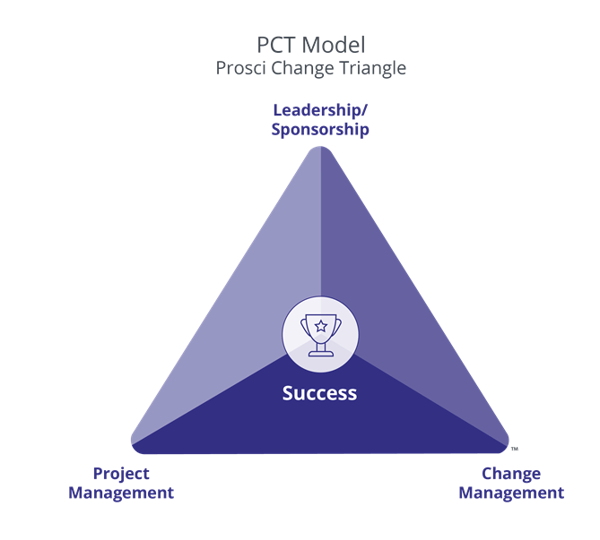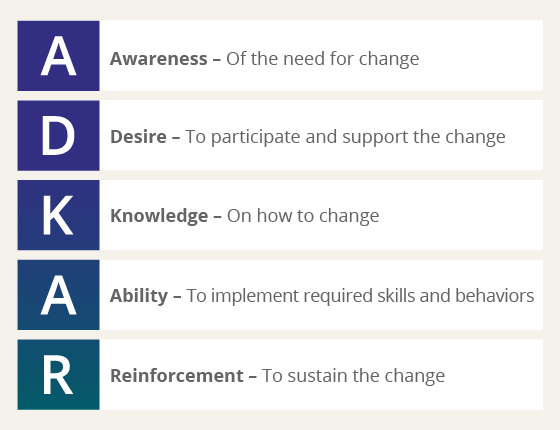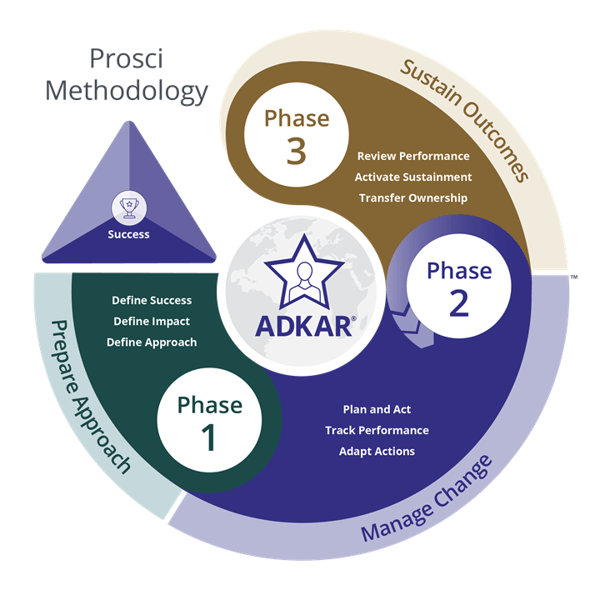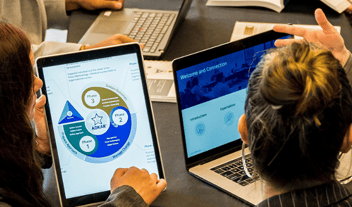Prosci Methodology
4 Mins
Updated: April 18, 2025
Published: March 29, 2021

The Prosci Methodology is based on the collective lessons learned by those implementing change across the globe. For more than two decades, change leaders, change teams and other key stakeholders have reflected on what worked, what did not, and what they would do differently on their next change project or initiative. Based on this ongoing research, Prosci developed a holistic and easy-to-use methodology—including a process, tools and assessments—which you can apply to projects while building your individual and organizational change management skillsets.
Change Management Methodology
Originally introduced in 2002, the Prosci Methodology was refreshed in 2021 to enable greater success for change practitioners. Today, practitioners around the globe agree that the refreshed methodology makes change management application even more effective, actionable and accessible.
The Prosci Methodology is a structured, adaptable and repeatable approach to enable the people side of change and deliver organizational results. Change practitioners apply the Prosci Methodology to create change management strategies and plans that increase adoption and usage on their critical change projects and initiatives.
The Prosci Methodology has global reach, puts people at the center of successful change, and comprises three key components:
- Prosci Change Triangle (PCT) Model – A framework depicting the four critical aspects of any successful organizational change
- Prosci 3-Phase Process – The critical link between individual change and organizational change management
- Prosci ADKAR® Model – A model for individual change
Prosci Change Triangle (PCT) Model
We change for a reason. The PCT Model helps clarify the reason by establishing the critical elements for success and providing a way to assess project health throughout the project lifecycle.
The PCT Model is a simple but powerful framework that shows the four critical aspects of any successful change effort: success, leadership/sponsorship, project management and change management.
Success is at the center of the model, and the other three aspects are at the corners:
- Success represents the purpose of an initiative or project
- Leadership/sponsorship represents the strategy and direction of an initiative or project
- Project management represents the technical side of an initiative or project
- Change management represents the people side of an initiative or project

It is critical to start any change initiative with a clear and aligned definition of success. This ensures that everyone is working towards the same finish line for the initiative.
The sides of the triangle connect the corners, representing how the three corners work with the other disciplines. Project management works with leadership/sponsorship on the leadership decisions that must be made. Change management works with leadership/sponsorship on leadership actions they must take. And change management works with project management to create an integrated approach to the change initiative.
Prosci ADKAR Model
Organizations don't change, individuals do. No matter how large of a project you are taking on, the success of that project ultimately lies with each employee doing their work differently, multiplied across all employees impacted by the change. Effective change management requires an understanding and appreciation of how one person makes a change successfully. Without an individual perspective, we are left with activities but no idea of the goal or outcome that we are trying to achieve.
Prosci's model of individual change is called the Prosci ADKAR Model. ADKAR is an acronym for Awareness, Desire, Knowledge, Ability and Reinforcement—the elements an individual needs to move through to achieve successful change:

The ADKAR Model describes successful change at the individual level. When an organization undertakes a project or initiative, the change only happens when the employees who must do their jobs differently can say with confidence, "I have the Awareness, Desire, Knowledge, Ability and Reinforcement to make this change happen."
Because it outlines the goals or outcomes of successful change, our ADKAR Model is an effective framework for:
- Planning change management activities
- Diagnosing gaps
- Developing corrective actions
- Supporting managers and supervisors
Prosci 3-Phase Process
Although change happens one person at a time, we use processes and tools that facilitate this change across groups and organizations. Created for organizational change efforts, the Prosci 3-Phase Process is a structured, adaptable and repeatable approach for managing the people side of change. It serves as a critical link between individual change management and organizational change, and enables practitioners to scale change management activities as needed to help people impacted by change move through their ADKAR transitions.

Phase 1 – Prepare Approach
The purpose of Phase 1 – Prepare Approach is to position the change for success by developing a customized and scaled change management strategy with the necessary sponsorship and commitment. The deliverable is a Change Management Strategy.
During Phase 1 – Prepare Approach, change practitioners work through three stages: Define Success, Define Impact and Define Approach. Their goal is to uncover answers to three important questions:
- What are we trying to achieve?
- Who has to do their jobs differently and how?
- What will it take to achieve success?
Phase 2 – Manage Change
The purpose of Phase 2 – Manage Change is to achieve adoption and usage of the change by creating and implementing a plan or plans that will move individuals and the organization through ADKAR transitions. The deliverable is a Master Change Management Plan.
Phase 2 – Manage Change is the longest of the three phases because this is where practitioners spend the bulk of their time preparing, equipping and supporting people through their ADKAR journeys. During this phase, change teams work through actions in three iterative stages: Plan and Act, Track Performance and Adapt Actions. The goal is to understand the answers to these questions:
- What will we do to prepare, equip and support people?
- How are we doing?
- What adjustments do we need to make?
Phase 3 – Sustain Outcomes
The purpose of Phase 3 – Sustain Outcomes is to realize the value of the change by ensuring the change is adopted and the organization is committed and prepared to sustain the change. The deliverable is a Change Management Closeout.
During Phase 3 – Sustain Outcomes, change teams work through three stages: Review Performance, Activate Sustainment and Transfer Ownership. Their goal is to answer these questions:
- Now, where are we?
- What is needed to ensure the change sticks?
- Who will assume ownership and sustain outcomes?
People at the Heart of Successful Change
The Prosci Methodology can be customized for all kinds of change initiatives where results and outcomes depend on adoption and usage, and adapted to work with a variety of development approaches. Because it's based on helping people through their individual ADKAR journeys, the Prosci Methodology can also be scaled for changes of any size and complexity. And because it includes the Prosci 3-Phase Process, the Prosci Methodology equips practitioners with a purpose-driven, performance-oriented process to achieve adoption and usage—and realize successful outcomes from change.



